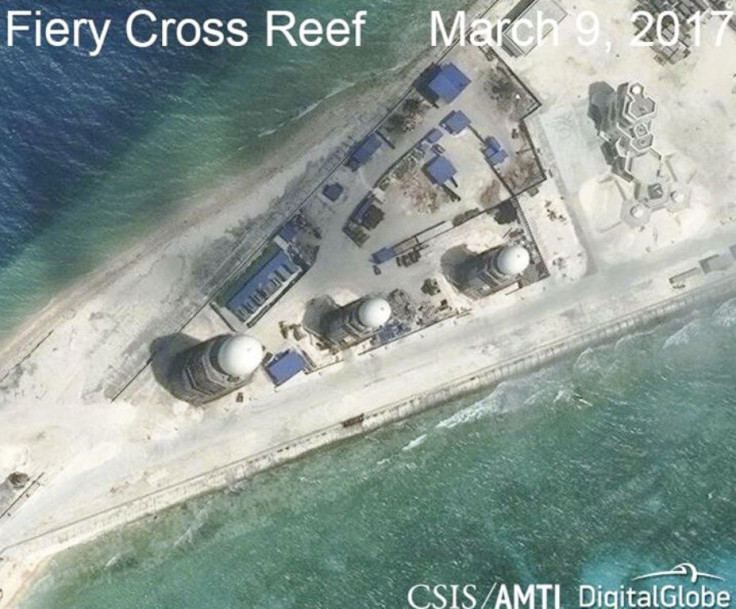China's 'Most Advanced' South China Sea Base Gets A Leg-Up — From Nature

KEY POINTS
- Freshwater was discovered under Beijing’s controversial man-made island named Fiery Cross Reef
- The water source is growing at a rate of about 1 meter (3.3 feet) per year
- The researchers claimed their computer modeling showed the freshwater body could stable in as little as 15 years
Mother Nature often serves up surprises that can help or hinder those who are in her path. The discovery of freshwater underneath one of Beijing’s controversial man-made islands in the South China Sea is just that.
Fiery Cross Reef, where the water was detected, is part of the disputed Spratly archipelago claimed by China, Vietnam, and the Philippines. Once a small coral atoll, China has spent about five years turning it into an island 10 times the original size and now occupies more than two sq. km (0.77 sq. miles).
The Centre for Strategic and International Studies, which is a Washington-based think tank, called Fiery Cross Reef Beijing’s “most advanced” artificial base in the South China Sea.
Researchers from the South China Sea Institute of Oceanology in Guangzhou said similar freshwater reservoirs could also be building up under other artificial islands across the region.
The water source is growing at a rate of about 1 meter (3.3 feet) per year, which is more than twice the speed observed on naturally formed islands, according to the Chinese study. Marine geologist Xu Hehua, who led the research team said the water could “serve as an important water resource for local inhabitants and ecosystems,” in a peer-reviewed paper in the Journal of Hydrology published in May.
The phenomenon is called a “freshwater lens” and occurs naturally on islands that receive a lot of rainfall. Fiery Cross Reef gets about 3,000 mm (118 inches) annually. Because the freshwater is less dense and thus lighter, it can form a layer over the heavier saltwater under ideal conditions. According to previous studies, it takes about 150 years to form naturally and become stable.
China’s unnatural buildup may be accelerating the process by a factor of 10, according to the paper by Xu, who wrote: “This process is very similar to the formation of natural coral islands, which mainly depends on storm or tidal waves to move and carry coral debris to form the island. [Land reclamation has] accelerated this process.”
The researchers claimed their computer modeling showed the freshwater body on Fiery Cross Reef becoming stable in as little as 15 years.
Beginning in 2015, China used dredgers and cranes to build on the reef. They moved sand from the shallow lagoon and pumped it into the coral reef to create an artificial island five meters (16 feet) above sea level. Typhoons and other extreme weather were responsible for saltwater flooding onto the island.
The water might not be considered a godsend by the Chinese Communist Party, but the inhabitants of the island will benefit greatly. The island currently uses desalination methods, most likely a reverse osmosis process that returns highly concentrated saltwater to the ecosystems. Freshwater is scarce and thus valuable.
Lu Chunhui, a professor of hydrogeology at Hohai University in Nanjing who was not involved in the study, warned about tapping into the freshwater lens too early at the risk of saltwater contamination into the reservoir. He suggested further studies be conducted to collect data on weather records, geological surveys, and other factors to estimate how much freshwater could be extracted without damaging the resource.
The professor added there are ways to stop seawater intrusion on the island, including building a wall. He said, “Such technology works not only on remote islands but in coastal cities with water problems such as Singapore and Hong Kong.”
© Copyright IBTimes 2025. All rights reserved.





















